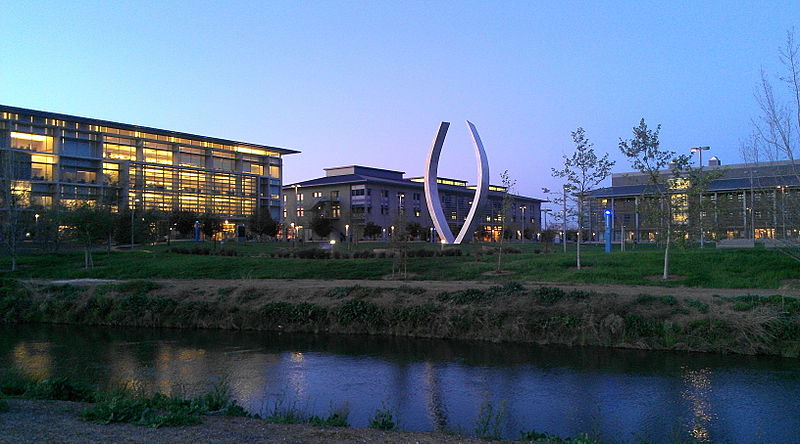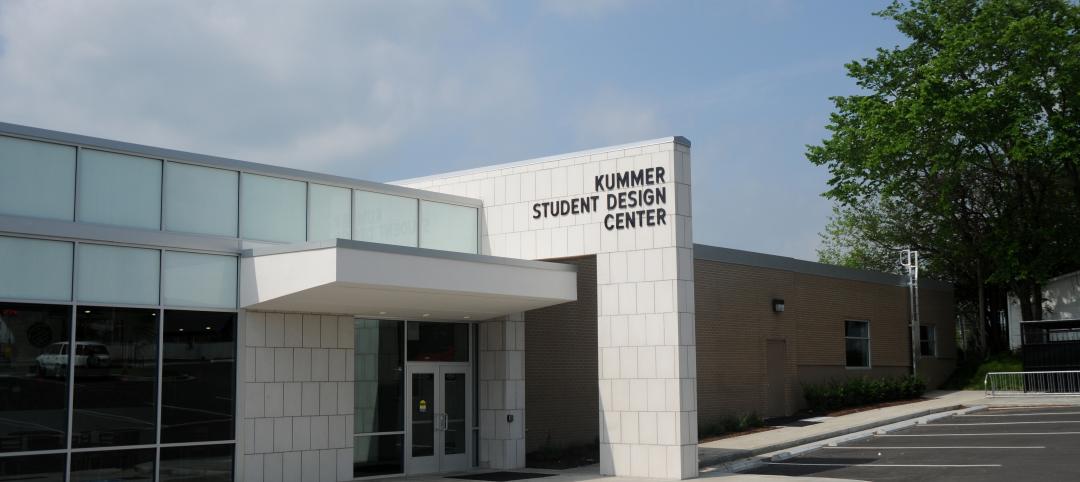The University of California, Merced, received another Leadership in Energy and Environmental Design (LEED) Platinum certification, this time for the Student Services Building.
The award brings the campus total for LEED certifications through the U.S. Green Building Council to 13, with its newest building, under construction, the second Classroom and Office Building (COB2), expected to also achieve Platinum status.
The campus is holding a topping-off ceremony for COB2 at 1 p.m. Tuesday, Dec. 9, with construction crews placing the uppermost beam on the building that’s expected to open in April 2016. Before the beam is placed, the campus community is invited to sign it, leaving marks and messages for anyone who might see it in the future.
UC Merced continues to be the only campus in the nation with LEED certification for all its facilities.
“UC Merced continues to pave the way in sustainable planning and design, frequently outperforming our objectives through the dedication and hard work of the consultants, contractors and staff involved and inspired by the vision of our leadership,” Campus Architect Thomas Lollini said.
The campus earned LEED Silver certification for the Garden Suites Lake View Dining building; eight Gold certificates for its Central Plant, Science & Engineering 1, the first Classroom and Office Building, the Leo and Dottie Kolligian Library, the Joseph Gallo Recreation Center, Sierra Terraces, Early Childhood Education Center and the Logistical Support/Safety Facility; and four Platinum certificates, for the dining expansion, the Social Science and Management building, the Student Activities and Athletic Center and now the Student Services Building. The Early Childhood Education Center is one of the first LEED Gold modular buildings in the country.
Platinum certifications are also pending on two residence halls, called The Summits, and on Science & Engineering 2, which opened this fall.
Earning LEED certifications for design is only one of the campus’s goals. The facilities department is also conducting audits of operations in every building on campus, from energy use to procurement procedures, to earn LEED recognition for the use and maintenance of the buildings.
The campus earlier this year won The California Architectural Foundation’s Owings Award for Environmental Excellence, recognizing UC Merced’s first development phase for its holistic view toward sustainability.
The campus’s master plan has won nine awards, including several from the American Institute of Architects, The Society of Campus and University Planners, the International Green Industry Hall of Fame, and the California Governor’s Environmental and Economic Leadership Award.
Though UC Merced has been honored for “cutting-edge sustainability in design and construction” of its buildings, the campus continues to undertake ambitious sustainability efforts, including its Triple Zero commitment to create zero landfill waste, consume zero net energy and produce zero net greenhouse gas emissions by 2020. The campus also plans to be nearly 90 percent powered by renewable energy by the end of 2016.
“There’s no other campus like UC Merced in the country,” Assistant Vice Chancellor of Strategic Facilities Planning Graeme Mitchell said. “This is a very special place.”
The campus pioneered the use of energy benchmarks, setting increasingly aggressive energy budgets for its buildings. Its buildings are designed to be 50% to 60% more energy efficient than their counterparts in the UC system, and 40 percent more water efficient.
Related Stories
| Sep 12, 2011
Living Buildings: Are AEC Firms up to the Challenge?
Modular Architecture > You’ve done a LEED Gold or two, maybe even a LEED Platinum. But are you and your firm ready to take on the Living Building Challenge? Think twice before you say yes.
| May 18, 2011
Major Trends in University Residence Halls
They’re not ‘dorms’ anymore. Today’s collegiate housing facilities are lively, state-of-the-art, and green—and a growing sector for Building Teams to explore.
| May 18, 2011
Raphael Viñoly’s serpentine-shaped building snakes up San Francisco hillside
The hillside location for the Ray and Dagmar Dolby Regeneration Medicine building at the University of California, San Francisco, presented a challenge to the Building Team of Raphael Viñoly, SmithGroup, DPR Construction, and Forell/Elsesser Engineers. The 660-foot-long serpentine-shaped building sits on a structural framework 40 to 70 feet off the ground to accommodate the hillside’s steep 60-degree slope.
| Apr 13, 2011
Duke University parking garage driven to LEED certification
People parking their cars inside the new Research Drive garage at Duke University are making history—they’re utilizing the country’s first freestanding LEED-certified parking structure.
| Apr 12, 2011
Rutgers students offered choice of food and dining facilities
The Livingston Dining Commons at Rutgers University’s Livingston Campus in New Brunswick, N.J., was designed by Biber Partnership, Summit, N.J., to offer three different dining rooms that connect to a central servery.
| Apr 12, 2011
College of New Jersey facility will teach teachers how to teach
The College of New Jersey broke ground on its 79,000-sf School of Education building in Ewing, N.J.
| Mar 23, 2011
After 60 years of student lobbying, new activity center opens at University of Texas
The new Student Activity Center at the University of Texas campus, Austin, is the result of almost 60 years of students lobbying for another dedicated social and cultural center on campus. The 149,000-sf facility is designed to serve as the "campus living room," and should earn a LEED Gold certification, a first for the campus.
| Mar 18, 2011
Universities will compete to build a campus on New York City land
New York City announced that it had received 18 expressions of interest in establishing a research center from universities and corporations around the world. Struggling to compete with Silicon Valley, Boston, and other high-tech hubs, officials charged with developing the city’s economy have identified several city-owned sites that might serve as a home for the research center for applied science and engineering that they hope to establish.















